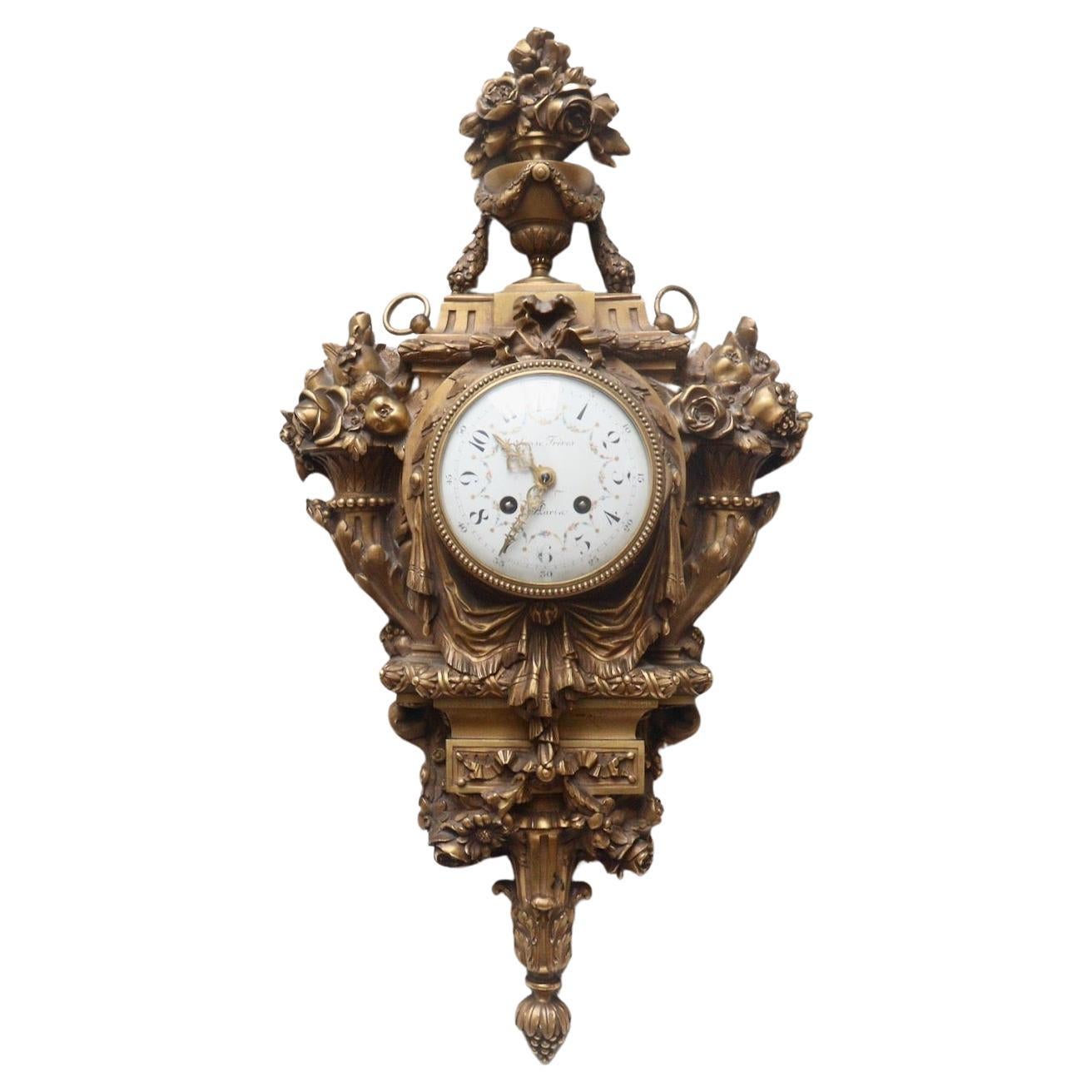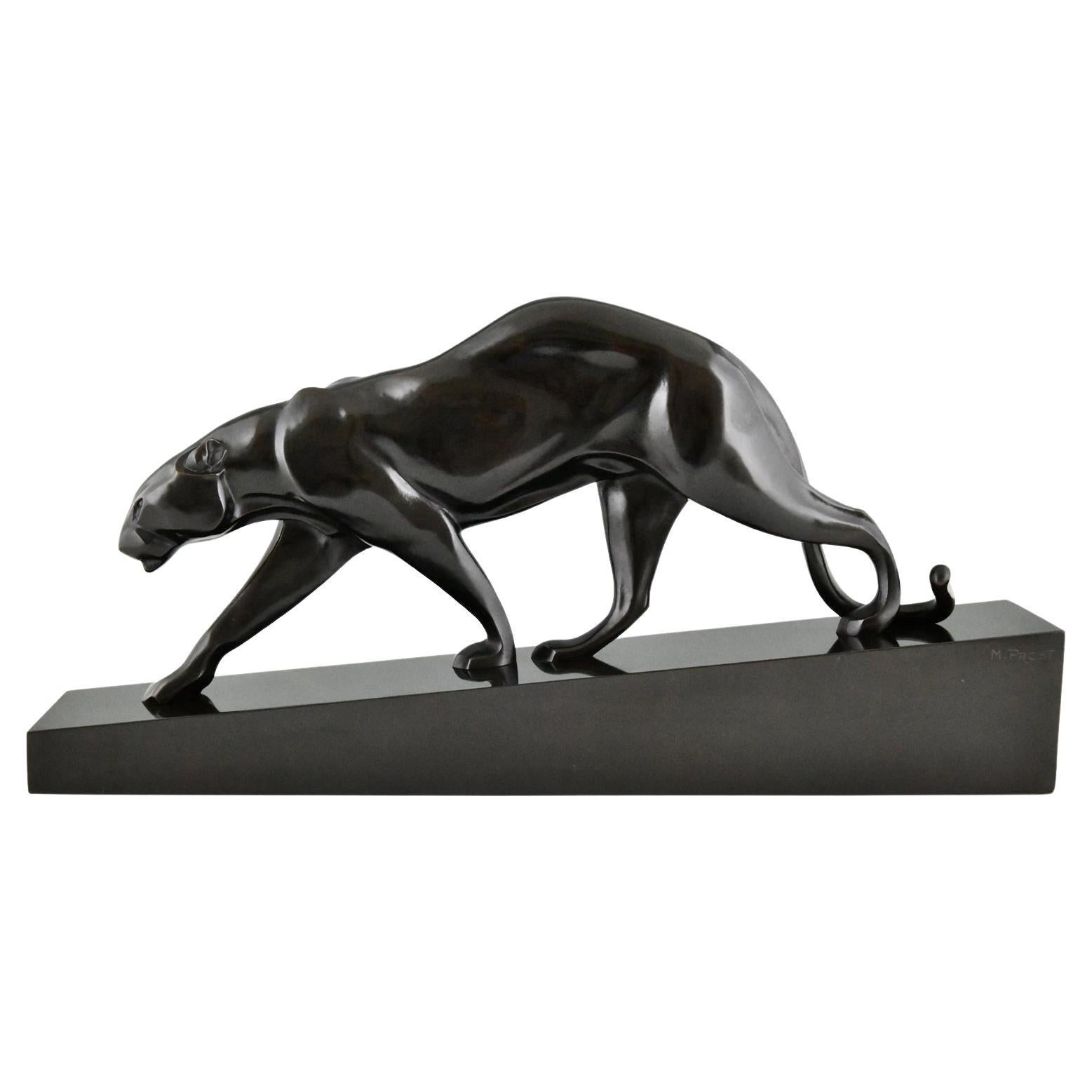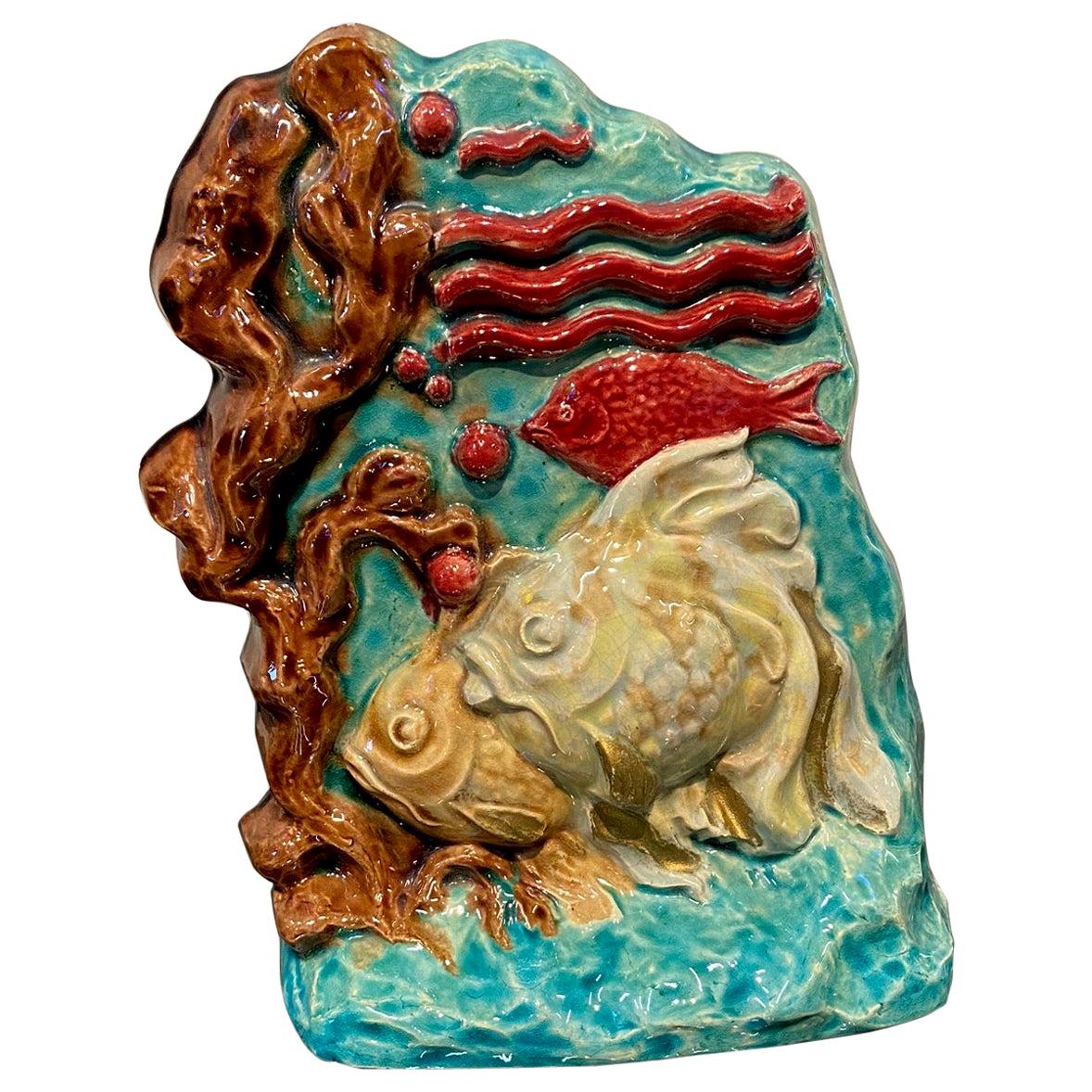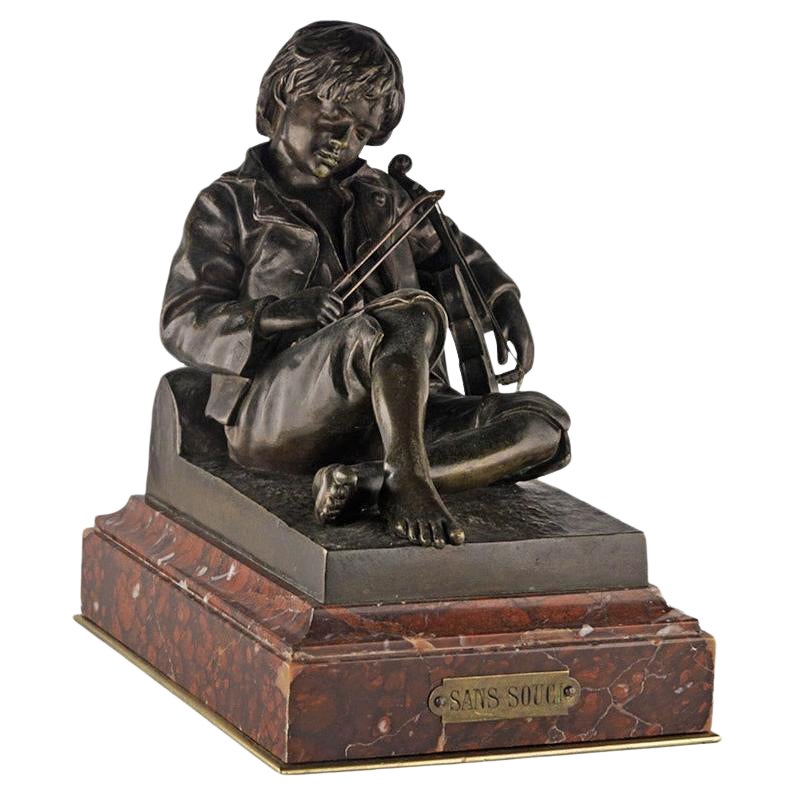Items Similar to Emperor Napoleon on Horseback, Cast by Susse Frères, Paris
Want more images or videos?
Request additional images or videos from the seller
1 of 21
Emperor Napoleon on Horseback, Cast by Susse Frères, Paris
About the Item
A Large Patinated Bronze Sculpture of Emperor Napoleon on Horseback, Cast by Susse Frères, Paris, From the Model By Alfred Émilien O'Hara, Comte de Nieuwerkerke (1811-1892).
Dark brown patinated bronze.
Depicting the Emperor Napoleon on horseback in military attire with distinctive frock coat and famous bicorne hat, one hand holding the horses reigns the other symbolically resting on his heart, the saddle cloth richly emblazoned with the imperial cypher.
Signed to the cast, "Nieuwerkerke 1850", with "Susse Edit" for the Susse Frères foundry. Stamped ‘SUSSE FRES’ above a leaf mark alongside an indistinct pressed oval mark.
This large bronze equestrian group of the Emperor Napoleon astride his famous mount Morengo is a reduction of the monumental statue by the Comte de Nieuwerkerke (1811-1892) commissioned for the town of Lyon in 1850. One of the most iconic representations of Napoleon, it successfully captured the essence of the legendary leader, embodying his indomitable spirit and military prowess. The monumental version stood at nearly four and half meters high. Cast by MM. Eck and Durand it was inaugurated in the sculptor's presence by the Louis-Napoléon Bonaparte (Napoleon III) on 20 September 1852 on the largest square on the Perrache peninsula (now place Carnot) in Lyon.
Writing in the ‘Revue Des Beaux Art’s in 1852 the critic A. Galimard (1813-1880) devoted two pages in praise of the sculptural group noting:
‘On s'occupe beaucoup dans le monde des arts de la statue équestre de l'empereur Napoléon , commandée à M. le comte de Nieuwerkerke par la ville de Lyon. La noblesse du sujet et la célébrité de l'artiste auquel cette difficile tache a éçé confiée , devait, ajuste titre , exciter la curiosité et les sympathies publiques.’
Praising Nieuwerkerke’s meticulous rendering of the subject and its composition, Galimard noted how some modern sculptors in an equivocal way had been known to sacrifice the man for the depiction of the horse. However, Nieuwerkerke’s sculpture subordinated the horse to the Emperor in such a way as to preserve the artistic truth and beauty for both horse and rider.
‘Quelques statuaires modernes n'avaient su allier l'homme au cheval, qu'à la triste condition de sacrifier le cavalier à sa monture; et ce parti pris a malheureusement doté nos places publiques de productions d'un goût équivoque. Mais tout en subordonnant le cheval de l'Empereur à l'Empereur lui-même, ce statuaire a su conserver au coursier du grand capitaine la vérité et la beauté dans l'art.’
In summary Galimard grandly concludes that in sculptural form it compares to the famous eulogies of the great men of the ancient world by authors such as Plutarch and Tacitus.
‘Historien avec le ciseau comme d'autres le furent avec la plume , M, le comte de Nieuwerkerke a fixé dans le bronze l'épopée impériale avec l'éloquente simplicité dont PIutarque et Tacite nous ont laissé d'impérissables modelés dans l'éloge de leurs grands hommes.’
The grand original bronze of ‘L'Empereur Napoléon Ier à cheval’ in Lyon was destroyed between November 1870 and February 1871. The only surviving full size version is a repetition with minor variations, inaugurated on 20 August 1854 at the centre of ‘place Napoléon’ in La Roche-Sur-Yon.
Having received such universal praise and popularity Nieuwerkerke’s seminal sculpture of Napoleon on Horseback was cast in reduction by the Susse Frères foundry as recorded in their sales catalogues in 1860 and 1875 offered in five sizes, the present size titled ‘1re Grandeur’ being the largest. Nieuwerkerke choosing to instruct Susse Frères to cast his sculpture in bronze is a practice evidenced by his being recorded to have entered into edition contracts with Susse Frères in 1838, for his group of fighting horseman, and in 1843, for his equestrian statue of William of Orange. Bronze reductions, produced as part of the edition, would be made according to demand. Examples of Napoleon on Horseback in this, the largest size, are very rare. The only known comparative reduction by Susse Frères is in the collection of the château de Compiègne. Indeed, Emperor Napoleon III’s Royal Warrant was issued to Susse Frères in 1854 and the imperial family went on to spend considerable sums with the foundry. Patronage was no doubt accredited by Nieuwerkerke’s role as Intendent of the Beaux-Arts of the Household of His Majesty.
Beyond its artistic significance, the statue symbolises the resilience of France, honouring a leader whose legacy continues to shape the nation's identity.
France, Circa 1860.
- Creator:Susse Freres (Maker)
- Dimensions:Height: 38.59 in (98 cm)Width: 35.44 in (90 cm)Depth: 13 in (33 cm)
- Materials and Techniques:Bronze,Patinated
- Place of Origin:
- Period:
- Date of Manufacture:Circa 1860
- Condition:Wear consistent with age and use.
- Seller Location:Brighton, GB
- Reference Number:
About the Seller
5.0
Recognized Seller
These prestigious sellers are industry leaders and represent the highest echelon for item quality and design.
Platinum Seller
These expertly vetted sellers are 1stDibs' most experienced sellers and are rated highest by our customers.
Established in 1964
1stDibs seller since 2014
48 sales on 1stDibs
Typical response time: 1 hour
Associations
The British Antique Dealers' AssociationLAPADA - The Association of Arts & Antiques Dealers
- ShippingRetrieving quote...Ships From: Brighton, United Kingdom
- Return PolicyA return for this item may be initiated within 7 days of delivery.
More From This SellerView All
- Bronze Seven-Light Candelabra After Clodion Cast, Suse Frères French circa 1890By Claude Michel Clodion, Susse FreresLocated in Brighton, West SussexA fine pair of gilt and patinated bronze seven-light candelabra, after a model by Clodion, Cast by Suse Frères. Stamped 'Susse Fres'. The candelabra are in the form of patinat...Category
Antique Late 19th Century French Louis XVI Candelabras
MaterialsBronze
- ‘Gloria Victis’, A Patinated Bronze Figural Group by Mercié, Cast by BarbedienneBy Ferdinand BarbedienneLocated in Brighton, West SussexA Patinated Bronze Figural Group of ‘Gloria Victis’ (‘Glory to the Vanquished’), Cast by Ferdinand Barbedienne from the Model by Marius-Jean-Antonin Mercié (French, 1845-1916). ‘Gloria Victis’ (‘Glory to the Vanquished’). Bronze, gilt and dark brown patina. Signed 'A. Mercié', with foundry inscription 'F. BARBEDIENNE, Fondeur. Paris.' and A. Collas reduction cachet. The integral base titled 'GLORIA VICTIS'. This cast is part of a limited edition by the Barbedienne Foundry. France. Circa 1880. ‘Gloria Victis’ is one of the most recognisable and important works of sculpture of the nineteenth century and a definitive image of France’s historic national identity. The figure of glory, winged and wearing armour, carries a dying young warrior heavenwards towards fame and immortality. The compositional daring of the group must be admired for balancing two figures on the minimal support of one foot, wings spread in the moment before taking flight. Mercié was a student at the French Academy of Rome when the Prussians invaded France in 1870. Shortly after the war had begun, he executed a group depicting the figure of Fame supporting a victorious soldier. When news reached Mercié in Rome that the French had surrendered, he decided to alter his group, replacing the victorious soldier with a defeated casualty, thus transforming an allegory of ‘Glory to the Victors’ into one of ‘Glory to the Vanquished’. Completed in 1872, a year after the defeat of French soldiers against the Prussian army, the statue personifies a defeated but heroic France. The title is also a reversal of the famous formula, ‘Vae Victis’ (Death to the Vanquished), which the Gallic general Brennus exclaimed upon defeating the Romans in 390 BC. The figure of the fallen soldier was thought to represent Henri Regnault, a fellow sculptor of Mercié who was killed on the last day of fighting. Measuring 317 cm. high the original group of ‘Gloria Victis’ was unveiled in plaster at the Salon of 1872. It was bought by the City of Paris for the sum of twelve thousand francs and then cast in bronze by Victor Thiébaut for eight thousand five hundred francs. The bronze was exhibited at the Salon in 1875 and first placed in Montholon Square in the 8th arrondissement. In 1884 it was transferred to the courtyard of the Hôtel de Ville and in 1930, it entered the collection of the Musée du Petit Palais, where it can be seen to this day. The Thiébaut Frères foundry also cast Gloria Victis bronzes for the cities of Niort (requested 1881) Bordeaux (requested 1883), Châlons-sur-Marne (today, Châlons-en-Champagne; requested 1890), and Cholet (requested 1901). In 1905, the Danish brewer and art collector Carl Jacobsen was permitted to have an exact cast made of the original sculpture in Paris, on condition that the base was made 2 cm lower and bore the inscription “Original tilhører Paris By” (The original belongs to the City of Paris). It too was cast by the Thiébaut Frères foundry. Gloria Victis was one of Jacobsen’s most important and his last acquisition. Today it has been returned to its original position in the Winter Garden at Glyptoteket, Copenhagen, Denmark. The full-size plaster was shown again at the Paris Expositon universelle of 1878 alongside a bronze reduction by Barbedienne. By this time Antonin Mercié had entered into a commercial edition contract with the Ferdinand Babedienne foundry to produce bronze reductions of Gloria Victis, his most famous work. Gloria Victis is first recorded to have been produced in three sizes and by 1886 Barbedienne’s ‘Catalogue des Bronzes D’Art’ lists six sizes measuring 3/5, 9/20, 7/20, 3/10, 6/25 and 2/10, of the original. These reductions were produced by an invention of Barbedienne’s business partner Achille Collas. The Collas reducing machine was a type of complex mechanical pantograph lathe that enabled sculpture to be mathematically measured and transcribed to scale, in the round, thus making a reduced size plaster from which a bronze could be cast. Mercié's modern sculpture had become an instant classic, even receiving an entry in the Nouveau Larousse Illustré. The success of the group undoubtedly lay in the fact that it was admired not just on an aesthetic level, but also on a patriotic level, particularly in its commemoration of heroism in defeat. Immediately ‘Gloria Victis’ was recognised as a national artwork, capable of arousing patriotism and casts were ordered from Barbedienne as local memorials commemorating the war’s dead for cities across France. ‘Gloria Victis’ was considered so much a part of France’s national identity that for the 1900 Paris Exhibition, Ferdinand Barbedienne’s nephew Gustave Leblanc, loaned a bronze example to feature as part of l’Exposition centennale de l’art français. Literature: For an interesting account of the process of creating a reduction in bronze of the Gloria Victis by Barbedienne and illustrations of the casting and finishing of the bronze see: 'Ferdinand Barbedienne': Theodore Child; Harper's new monthly magazine, Volume 73, Issue 436, September 1886. ‘Contemporary French Sculptors’: The Century, Volume 33, Issue 3, Jan 1887. ‘Modern French Sculpture’: Harper's new monthly magazine, Volume 76, Issue 452, January 1888. S, Lami, ‘Dictionnaire des sculpteurs de l'Ecole française au dix-neuvième siècle’, Tome III. G.-M., Paris, 1914, p. 432. Peter Fusco and H.W. Janson, The Romantics to Rodin: French Nineteenth Century Sculpture from North...Category
Antique 19th Century French Figurative Sculptures
MaterialsBronze
- 'The Soldier of Marathon' Bronze after a Model by Cortot Cast by BarbedienneBy Jean Pierre Cortot, Ferdinand BarbedienneLocated in Brighton, West Sussex'The Soldier of Marathon' - A large patinated bronze group after a model by Jean-Pierre Cortot, Cast by Ferdinand Barbedienne. Jean-Pierre Cort...Category
Antique Late 19th Century French Figurative Sculptures
MaterialsBronze
- 'Le Puits Qui Parle' an Exhibition Bronze, Paul Eugène Mengin French, circa 1900By Paul Eugène Mengin 1, Susse FreresLocated in Brighton, West Sussex'Le Puits Qui Parle' (The Speaking Well) - An Important Exhibition Bronze Group, by Paul Eugène Mengin. Signed to the cast 'P MENGIN', and inscri...Category
Early 20th Century French Figurative Sculptures
MaterialsBronze
- Napoleon III Clock Garniture Designed by Sévin, Cast by BarbedienneBy F. Barbedienne Foundry, Louis-Constant SevinLocated in Brighton, West SussexA fine Napoleon III gilt-bronze and porcelain mounted clock garniture, designed by Louis-Constant Sévin, cast by Ferdinand Barbedienne, The Movement by Japy Frères. Frédéric Japy ...Category
Antique 19th Century French Napoleon III Mantel Clocks
MaterialsOrmolu
- A Large Cast Iron Fountain Figure of a Water Nymph, By J.J. Ducel, ParisBy Ducel FoundryLocated in Brighton, West SussexA Large Cast Iron Fountain Figure of a Water Nymph On a white marble pedestal, By J.-J. Ducel, Paris. Signed ' 'J.-J.DUCEL'. Modelled seated on a rock as if dipping a toe into th...Category
Antique 19th Century French Fountains
MaterialsMarble, Iron
You May Also Like
- A French Napoléon III Ormolu Cartel Clock by Susse Frères Paris circa 1870By Susse FreresLocated in Saint-Ouen, FRA French 19th Century Cornucopia Gilt-Bronze Cartel, by Susse Frères Paris An Ormolu Cartel in the shape of an escutcheon, with a circular white enamel dial, signed Susse Frères/A Paris, Arabic numerals for the hours and for the minutes. It's bordered by a frieze of pearls and surmounted by a falling laurel knot with a drapery in the lower part and flanked by cornucopias adorned with flowers and fruits. Rectangular base decorated with a garland of knotted flowers dying in a tapered, fluted barrel and damping, in the upper part, a flowery Medici vase. Louis XVI Style Circa 1870 Original gilding uncleaned The Susse company, a worldwide reknown foundry, began to cast pieces as soon as the first half of the 19th Century. Awarded medals...Category
Antique 1860s French Louis XVI Wall Clocks
MaterialsOrmolu
- Art Deco Bronze Sculpture Panther by Maurice Prost, Susse Frères Foundry, 1930By Susse Freres, Maurice ProstLocated in Antwerp, BEArt Deco bronze sculpture of a panther by Maurice Prost. Signed M. Prost and Susse frères Editeurs Paris. Bronze with black patina on a Belgian Black Marble base. This bronze is...Category
Vintage 1930s French Art Deco Animal Sculptures
MaterialsBelgian Black Marble, Bronze
- French Art Deco Ceramic Sculpture with Fishes, Glazed, 1920 by Susse FreresBy Susse FreresLocated in Hamburg, DEFrench Art Deco ceramic sculpture with fishes, glazed, 1920 by Susse Freres. Unique handmade ceramic sculpture from Paris, France. The pictured fish and underwater landscape is elabo...Category
Vintage 1930s French Art Deco Animal Sculptures
MaterialsCeramic
- Grand Tour Bronze, Roman Woman, France, 19th Century by Susse FreresBy Susse FreresLocated in West Palm Beach, FLThis bronze was produced by the firm of Susse Freres in France at the end of the 19th century during the "Grand Tour" of Europe. The piece has aged to a beautiful soft coloration. F...Category
Antique Late 19th Century French Neoclassical Revival Figurative Sculptures
MaterialsBronze
- French Bronze Sculpture of Violinist "Sans Souci" by Tharel for Susse FrèresBy Susse Freres, Leon TharelLocated in North Miami, FLLate 19th century french patinated bronze sculpture of violinist 'Sans Souci' with marble base by Léon Tharel for Susse Frères By: Léon Tharel, Susse Frères Material: bronze, metal, marble Technique: cast, patinated, hand-crafted, metalwork Dimensions: 6.5 in x 9 in x 9.5 in Date: late 19th century, circa 1890 Style: Belle Époque, Romanticism Place of origin: France Antique reclining...Category
Antique Late 19th Century French Belle Époque Figurative Sculptures
MaterialsMarble, Bronze, Metal
- Paul Silvestre Silvered Bronze Model of Diana for Susse FreresBy Paul Silvestre, Susse FreresLocated in London, GBThis stunning silvered bronze model is the work of the French sculptor Paul Silvestre (1884-1976) for Susse Freres, the famous metalworking firm based in Paris in the late 19th and e...Category
Early 20th Century French Art Nouveau Figurative Sculptures
MaterialsBronze
Recently Viewed
View AllMore Ways To Browse
Pino Signoretto Murano Sculpture
African Warrior Bronze
Dying Gaul Marble
Renda Bronze
Petite Goddess Mahapratisara Charm
Wooden Office
Marble God
Young Head Marble
Gladenbeck Foundry Bronze
Hermes Head Sculpture
Bronze Boy With With Shell
Barovier Glass Figurines
Dresden Nodders
Napoleone Martinuzzi Succulents
French Tapiz
Schierholz Plaue
Theodore Haviland Art Deco
Grand Tour Boxer





